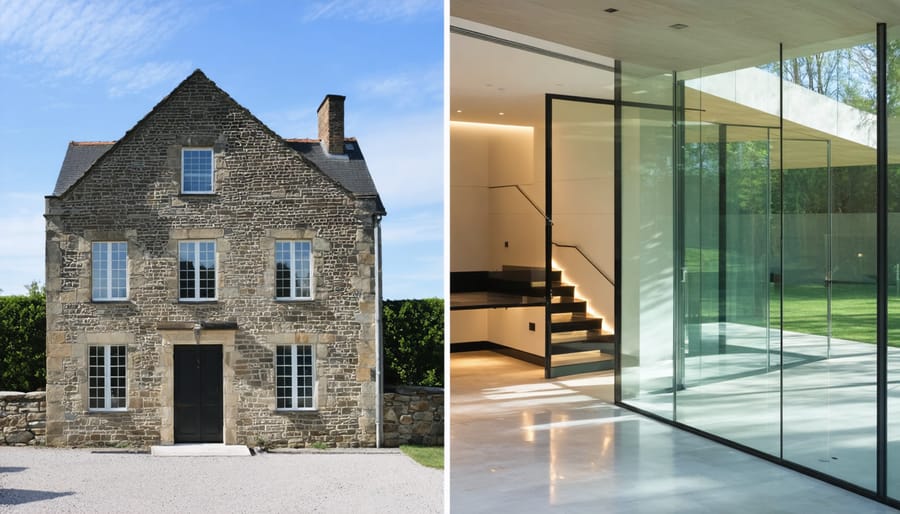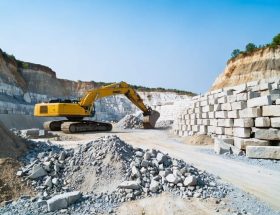Transform centuries-old stone houses into modern living spaces while preserving their historic character through proven cost-effective renovation strategies. Reinforce deteriorating mortar joints with compatible lime-based materials to prevent structural issues and maintain authentic construction methods. Install discrete insulation systems behind stone walls using breathable materials like sheep’s wool or wood fiber to enhance energy efficiency without compromising the building’s natural moisture regulation. Preserve original stone features by carefully cleaning surfaces with appropriate non-abrasive techniques, removing harmful modern cement repairs, and implementing proper drainage solutions to prevent water damage.
Stone houses represent architectural masterpieces that blend rugged durability with timeless beauty. Their renovation demands a delicate balance between modern comfort and historical preservation. Whether working with a centuries-old farmhouse or a mid-century stone cottage, the right renovation approach enhances these unique structures’ inherent strength while adapting them for contemporary living standards.
Assessing Your Stone House’s Condition
Common Structural Issues
Stone houses commonly develop structural issues over time that require careful attention during renovation. Mortar deterioration is one of the most frequent problems, where the binding material between stones weakens and crumbles, compromising the wall’s integrity. This typically occurs due to age, weather exposure, and poor maintenance.
Water damage presents another significant challenge, often manifesting as dampness in walls, efflorescence (white mineral deposits), or moss growth. Poor drainage, damaged gutters, or inadequate waterproofing can lead to water infiltration, which weakens the stone structure over time.
Foundation settling is particularly concerning in older stone houses. Signs include diagonal cracks in walls, uneven floors, or doors that no longer close properly. This usually results from soil conditions changing beneath the foundation or inadequate original construction methods.
Other common issues include bulging walls, which indicate structural instability, and damaged lintels above windows and doors. Regular inspection of these areas is crucial, as early detection can prevent more severe problems and reduce renovation costs. Professional assessment is recommended to determine the extent of structural issues before beginning any renovation work.
Professional Assessment Guidelines
Before undertaking any significant stone house renovation, engaging qualified professionals for a thorough structural assessment is crucial. A structural engineer should be consulted when dealing with load-bearing walls, foundation issues, or any signs of structural instability such as cracks wider than 1/4 inch, bulging walls, or settling concerns.
Stone masonry experts should be brought in early during the planning phase to evaluate the condition of existing stonework, mortar integrity, and potential water damage. These specialists can identify original construction techniques and recommend appropriate restoration methods that preserve the building’s historical character while ensuring structural soundness.
Schedule professional assessments during dry weather when possible, as moisture can mask underlying issues. Expert evaluation typically includes moisture testing, mortar analysis, and structural stability calculations. The assessment report should detail recommended repairs, estimated costs, and a prioritized timeline for addressing issues.
For major renovations, consider assembling a team that includes both a structural engineer and stone mason to ensure comprehensive evaluation and coordinated solutions. This collaborative approach helps prevent conflicts between structural requirements and preservation goals.
Essential Stone Restoration Techniques
Repointing and Mortar Repair
Repointing and mortar repair are crucial maintenance tasks for stone houses, ensuring their structural integrity and aesthetic appeal. The process begins with a thorough inspection of existing mortar joints to identify areas of deterioration, crumbling, or missing mortar.
Start by removing damaged mortar using appropriate tools such as a hammer and chisel or specialized raking tools. Work carefully to avoid damaging the surrounding stonework. Clean out the joints to a minimum depth of 2-3 times their width, typically about 1-2 inches deep, ensuring all loose material is removed.
Selecting the right mortar mix is essential. Historic buildings typically used lime-based mortars, which allow the structure to “breathe” and accommodate natural movement. Modern cement-based mortars are often too hard and can damage historic stonework. Match the original mortar’s composition by having a sample analyzed if possible.
Before applying new mortar, thoroughly dampen the joints to prevent rapid drying. Using a pointing tool or mortar bag, pack the new mortar firmly into the joints, working in small sections. Tool the joints to match the original profile once the mortar reaches thumb-print hardness. Keep the newly pointed areas damp for several days to ensure proper curing.
For optimal results, avoid repointing in extreme weather conditions. Temperatures should ideally be between 40-90°F (4-32°C), and the work area should be protected from direct sunlight, wind, and rain during application and curing.
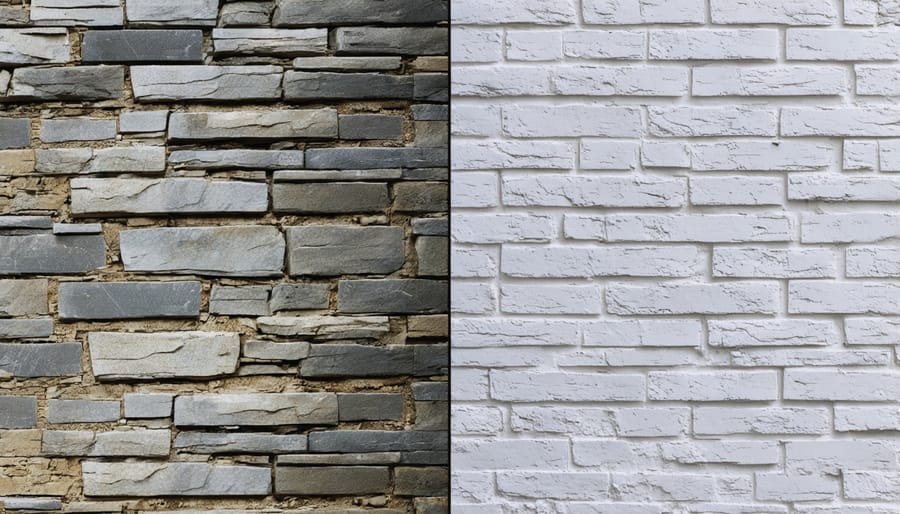
Stone Cleaning and Treatment
Proper cleaning and treatment of stone surfaces is crucial for maintaining your home’s historic character and structural integrity. Different types of stone require specific cleaning approaches to prevent damage while effectively removing dirt, biological growth, and environmental stains.
For limestone and sandstone, use pH-neutral cleaners specifically formulated for natural stone. Avoid acidic solutions, which can etch these sensitive materials. Gentle pressure washing at low settings can be effective, but always test on a small, inconspicuous area first. When tackling stone facade restoration, work from bottom to top to prevent streaking.
Granite and slate are more resilient but still require appropriate care. Use stone-specific cleaners and soft brushes to remove surface dirt. For stubborn stains, poultice treatments can draw out deep-set discoloration without damaging the stone’s surface.
After cleaning, apply a penetrating sealer appropriate for your stone type to protect against moisture infiltration and staining. Most exterior stone surfaces benefit from resealing every 3-5 years, depending on exposure to weather elements. Regular maintenance, including gentle cleaning with appropriate products and prompt attention to any damage or staining, will help preserve your stone’s beauty and structural integrity for generations to come.
Replacing Damaged Stones
When restoring a stone house, replacing damaged stones requires careful consideration and precise execution. Begin by thoroughly assessing the deteriorated stones and documenting their exact size, color, and texture patterns. Sourcing matching stones is crucial – work with specialized quarries or architectural salvage yards that can provide historically appropriate materials. Consider that weathering will have affected the original stones’ appearance, so new stones may initially appear slightly different but will naturally age over time.
Before removing damaged stones, photograph and number each one to maintain the original pattern. Use appropriate stone repair techniques to carefully extract damaged pieces without compromising surrounding stonework. Clean the cavity thoroughly and prepare the replacement stone by cutting and shaping it to match the original dimensions precisely.
When setting new stones, use historically appropriate mortar mixtures that match the original composition. This ensures proper binding and prevents future deterioration due to incompatible materials. Pay attention to the joint width and pointing style to maintain visual consistency. Allow adequate curing time before exposing newly replaced stones to weather conditions.
For best results, consider working with a mason experienced in historic restoration, as they’ll understand the nuances of matching stone types and traditional installation methods. Remember that proper replacement now will prevent more extensive repairs in the future.
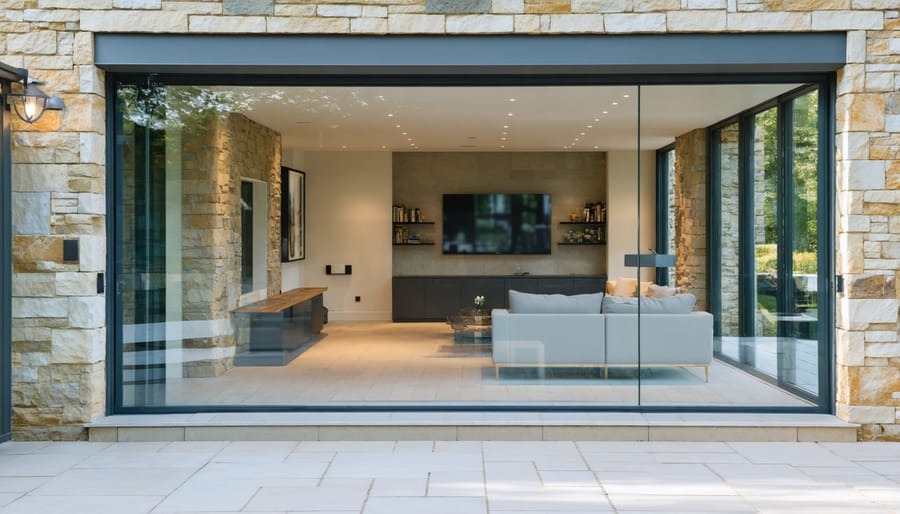
Modern Upgrades That Complement Stone Architecture
Energy-Efficient Solutions
Stone houses present unique challenges for energy efficiency, but with the right approach, they can be transformed into comfortable, sustainable homes. The key lies in understanding the natural thermal properties of stone while implementing modern insulation solutions.
Internal wall insulation using breathable materials like wool or hemp is particularly effective for stone houses, as it preserves the walls’ ability to regulate moisture while improving thermal performance. For optimal results, combine this with a vapor-permeable membrane that prevents condensation buildup within the walls.
Traditional stone houses benefit significantly from roof insulation, as up to 25% of heat loss occurs through uninsulated roofs. Natural materials like sheep’s wool or cellulose provide excellent thermal properties while maintaining the building’s historic character.
When it comes to climate control, consider installing a zoned heating system that allows for precise temperature management in different areas of the house. Heat pumps are increasingly popular for stone properties, offering efficient heating and cooling while reducing energy consumption.
Windows in stone houses often contribute to significant heat loss. Installing secondary glazing or energy-efficient replacement windows designed specifically for historic properties can dramatically improve thermal performance without compromising the building’s aesthetic appeal.
Floor insulation shouldn’t be overlooked – installing underfloor heating combined with appropriate insulation materials can provide efficient, comfortable warmth while working harmoniously with the stone structure’s thermal mass properties.
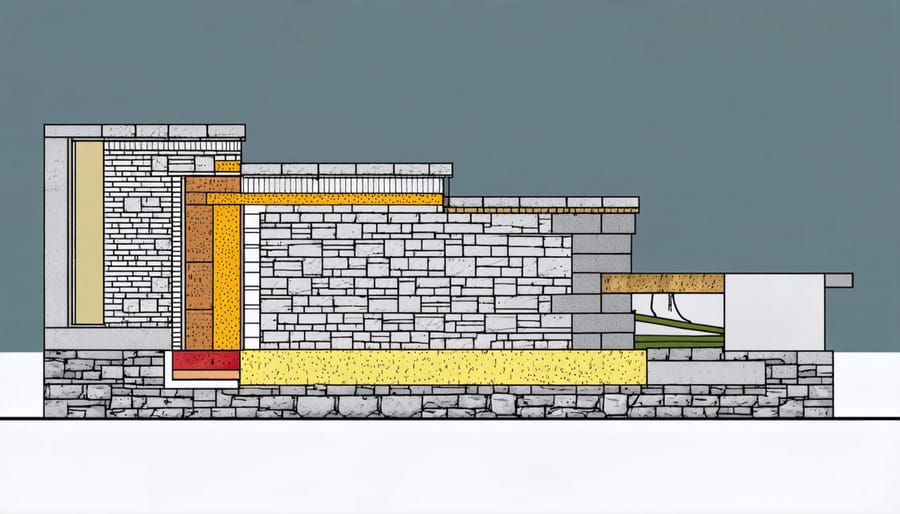
Lighting and Electrical Updates
Modernizing a stone house’s electrical system requires careful planning to maintain the structure’s historic integrity while meeting contemporary needs. The key challenge lies in routing wiring through thick stone walls without compromising their structural stability or aesthetic appeal.
One effective approach is surface-mounted conduits, which can be painted to match wall colors or deliberately styled as industrial design elements. For a more concealed solution, consider running electrical lines through floor joists or existing chase ways where possible. Installing new outlets and switches may require creating small channels in the mortar joints rather than cutting directly into stonework.
Lighting design should complement the stone’s natural texture while providing adequate illumination. Consider installing LED strips behind crown molding for ambient uplighting that highlights stone textures. Wall sconces mounted on mortar joints offer both functional light and decorative appeal without disturbing the stone itself.
Smart home technology can be integrated using wireless systems, minimizing the need for extensive wiring. Wireless switches and smart bulbs provide modern convenience while preserving historic walls. For outdoor lighting, ground-mounted fixtures can dramatically illuminate stone facades without requiring wall penetration.
When planning electrical updates, work with professionals experienced in historic renovations. They can suggest creative solutions like false walls in select areas to house modern utilities or utilizing existing chimney flues as vertical chases for new wiring.
Window and Door Modernization
Modernizing windows and doors in a stone house requires careful consideration to maintain the building’s historic character while improving energy efficiency and functionality. Original wooden windows and doors can often be restored rather than replaced, preserving architectural authenticity through careful repairs and weatherstripping upgrades.
When replacement is necessary, choose materials and designs that complement the stone façade. Custom-made wooden windows and doors, crafted to match historical profiles, offer the most authentic appearance. Modern materials like aluminum-clad wood provide durability while maintaining traditional aesthetics.
Consider installing secondary glazing or double-glazed units within existing frames to improve thermal performance without compromising the exterior appearance. Storm windows and doors can provide additional insulation while protecting original features.
Pay special attention to maintaining proper water management around openings. Install appropriate flashing and ensure proper sealing between the stone walls and window or door frames. Historical homes often benefit from traditional lime-based pointing around openings rather than modern cement-based materials.
For doorways, consider adding discrete weather seals and updating hardware while keeping original door designs. Period-appropriate lighting fixtures can enhance entryways without detracting from historical accuracy.
Remember that local preservation guidelines may affect modification options, particularly in designated historic districts. Always consult preservation specialists when undertaking significant changes to openings in historic stone structures.
Interior Design Strategies
Exposed Stone Features
Exposing original stonework within your home creates a striking visual connection to the building’s heritage while adding authentic character to your interior spaces. These natural stone design features can become dramatic focal points that celebrate the structure’s history and craftsmanship.
Start by carefully removing any covering materials like drywall or plaster to reveal the stone underneath. Have a structural engineer assess the integrity of the exposed stonework before proceeding. Once cleared, clean the stone surfaces using appropriate conservation methods that won’t damage the historic material.
Consider exposing stone features in areas where they’ll create maximum impact, such as:
– Living room or great room accent walls
– Kitchen backsplashes and cooking alcoves
– Fireplace surrounds and chimney breasts
– Interior archways and doorways
– Basement walls and foundation elements
To enhance exposed stonework, install strategic lighting that highlights the texture and natural variations in the stone. Uplighting, wall washers, or picture lights can create dramatic shadows that emphasize the three-dimensional quality of the masonry.
When incorporating modern elements alongside exposed stone, maintain a balanced approach. Choose complementary materials and colors that allow the original stonework to remain the protagonist in your design story. This thoughtful integration of old and new creates spaces that feel both historically grounded and contemporarily relevant.
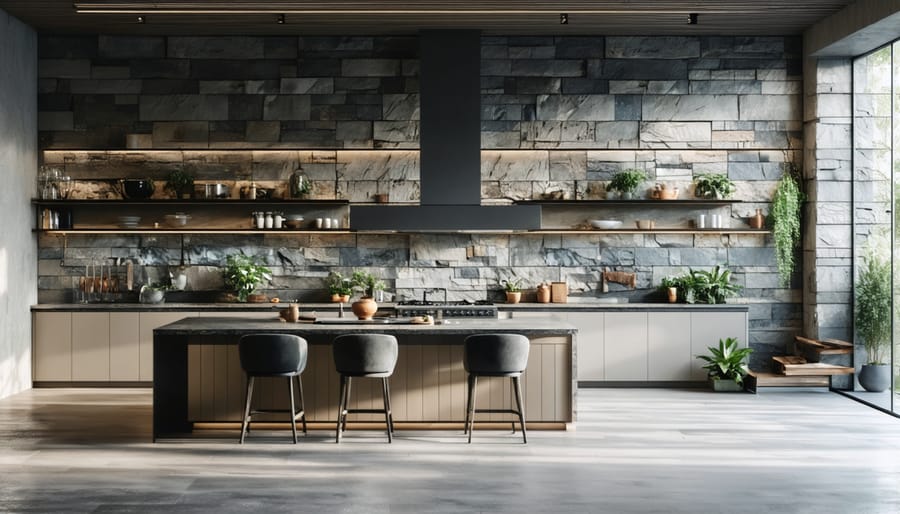
Contemporary Additions
Contemporary additions to stone houses require thoughtful integration to maintain architectural harmony while introducing modern functionality. Glass extensions serve as popular choices, creating a striking contrast between historic stonework and sleek transparency. These additions allow natural light to flood interior spaces while providing clear visual separation between old and new elements.
Steel-framed structures complement stone walls particularly well, offering minimal visual interference and structural stability. When designing modern kitchen or living space extensions, consider using materials that echo the texture and color of existing stonework without directly mimicking it. Zinc or copper cladding naturally weathers over time, developing patinas that harmonize with aged stone.
For interior updates, floating staircases and open-plan layouts can transform traditionally compartmentalized stone houses into flowing modern spaces. Installing large-format windows or sliding glass doors within existing stone openings modernizes the structure while preserving its historical character. Contemporary lighting solutions, such as recessed LED strips or architectural spotlights, can dramatically highlight stone textures and create ambient effects.
When adding modern amenities like heating systems or smart home technology, careful planning ensures minimal impact on original stonework. Consider underfloor heating instead of wall-mounted radiators, and wireless systems that reduce the need for extensive wiring through stone walls. The key lies in creating additions that respect and enhance the original structure’s character while meeting contemporary lifestyle needs.
Renovating a stone house represents more than just a construction project – it’s an investment in preserving architectural heritage while creating a comfortable, modern living space. Throughout this journey, we’ve explored various approaches to breathe new life into these historic structures while maintaining their unique character and charm.
The key to successful stone house renovation lies in striking the perfect balance between preservation and modernization. By carefully considering each element – from structural reinforcement to interior updates – homeowners can create spaces that honor the past while embracing contemporary comfort and functionality.
Remember that every stone house tells its own story, and your renovation should aim to add a thoughtful new chapter rather than completely rewriting the narrative. Whether you’re updating the heating system, reinforcing walls, or redesigning interior spaces, each decision should respect the building’s original character while improving its livability for modern times.
The investment in proper materials, skilled craftspeople, and appropriate techniques may seem substantial initially, but the long-term benefits far outweigh the costs. A well-executed stone house renovation not only increases property value but also ensures these architectural treasures continue to stand proud for generations to come.
As you embark on your own stone house renovation journey, take time to research, plan, and consult with experienced professionals. Consider how each modification will impact both the historical integrity and practical functionality of your home. Don’t be afraid to incorporate modern elements where appropriate, but always do so with intention and respect for the original structure.
The enduring appeal of stone houses lies in their ability to bridge past and present, creating spaces that feel both timeless and contemporary. By approaching renovation with careful consideration and respect for traditional craftsmanship, while embracing modern innovations where appropriate, you can create a home that stands as a testament to both historical preservation and modern living.

